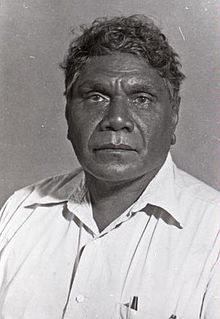Oil painting -> List of Painters -> Albert Namatjira
EARLY DAYS:
Albert Namatjira, one of Australia's most renowned Indigenous artists, was born on 28 July 1902 in Hermannsburg, a Lutheran Mission Station in Central Australia, to the Aranda people. Albert was the youngest son of the Aranda leader, Ullata and his wife, Ngipi.
Namatjira's childhood was spent learning the traditional Aranda lifestyle and culture including the language, hunting, gathering, and ceremonies. At the Mission, he received a basic education, and by the age of 13, he had mastered the German language. Namatjira was also a skilled stockman and was hired to work for the mission for most of his life.
In 1929, Namatjira met the Australian artist Rex Battarbee who had been commissioned by the Commonwealth government to paint a series of watercolour landscapes in the Hermannsburg area. Namatjira was captivated by Battarbee's work and asked to paint with him. Battarbee taught Namatjira the basics of watercolour painting and encouraged him to develop his own style.
By the early 1930s, Namatjira had developed a distinctive style and was producing works that were beginning to attract attention. His first exhibition was held at the Austral Gallery in Melbourne in 1938, and he quickly became a celebrated artist in Australia.
In 1939, Namatjira was the first Aboriginal person to be granted Australian citizenship. He was also granted the right to travel freely, something that was denied to most Indigenous Australians at the time.
Namatjira's paintings depicted the landscape of Central Australia in a unique and beautiful style. He often focused on the colours of the desert in his work, and his paintings often featured traditional Indigenous symbols and patterns.
Namatjira's work was highly sought after, and in 1948 he was the first Aboriginal person to be featured on an Australian postage stamp. He was also awarded an MBE in 1959 in recognition of his significant contributions to the arts.
Namatjira's works have been shown in galleries and museums around the world, and his paintings can be found in the collections of some of the world's most prestigious galleries.
In 1959, at the age of 57, Albert Namatjira died after a long illness. He left behind a legacy of art that continues to inspire and influence generations of Indigenous artists. His work is a testament to the power of art to transcend cultural boundaries and to bring people together.

Personal Details:
CAREER:
Namatjira began painting in watercolors. He was introduced to the art form by his uncle, Walter Ebatarinja, and was taught to paint by an English artist, Rex Battarbee. Battarbee was impressed with the young man's talent and encouraged him to develop his own style.
Namatjira's style was distinctive and quickly gained attention. He painted with vibrant colors that captured the beauty of the Australian landscape. His paintings depicted the red desert, its rugged hills and rocky outcrops, and the wildflowers that grew in the area. His use of color and light was unique and captivated viewers.
Namatjira's work quickly gained attention and he was soon invited to exhibit his paintings in major Australian cities. He was the first Aboriginal artist to gain national and international recognition. He became a celebrity and was featured in newspapers, magazines, and television programs.
He was also the first Aboriginal artist to be granted Australian citizenship, which allowed him to travel freely around the country. He used his fame and influence to advocate for Aboriginal rights and for better living conditions for his people. In 1954, he was made an Officer of the Order of the British Empire for his services to the arts.
Namatjira's art was highly sought after and he was able to provide a comfortable lifestyle for his family. He used his wealth to purchase land for the Arrernte people and to help fund the construction of a new church in Hermannsburg.
In 1959, Namatjira suffered a stroke and died at the age of 57. He left behind a legacy of art and advocacy that continues to be celebrated today. His artworks are held in major galleries and museums in Australia and around the world, and his influence can be seen in the work of many contemporary Aboriginal artists.



